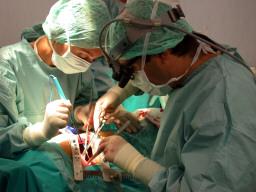An Italian hospital has carried out the world's first shoulder transplant.
A team at Bologna's Rizzoli hospital inserted a 2-cm-wide chunk of bone and cartilage to replace the arthritic joint of a 47-year-old former amateur bodybuilder.
The patient, Giampiero Cocchini, had been suffering from 'severe post-traumatic arthrosis' which had completely consumed the cartilage in his right shoulder.
''The pain used to be continual, especially at night. I couldn't sleep,'' Cocchini told reporters in his hospital room.
''I couldn't get dressed, drive a car or carry even the lightest load''.
Cocchini, a municipal council worker from Pescara, is doing well and is expected to be released on Thursday, doctors said. He should be able to take the bandage off in a month.
''I'm looking forward to holding an ice cream or having the odd game of tennis,'' Cocchini smiled, looking with amazement as he managed to flex his fingers again.
The bone was taken from a 38-year-old car-crash victim who died ten days ago.
''I thought about the person who donated the joint. It was a generous act,'' Cocchini said.
The new technique has been dubbed 'biological' because the bone ''maintains vitality in the cartilage cells,'' said Chief Surgeon Sandro Giannini, who has already made advances in replacing knees, ankles and big toes.
The graft, which was attached to the collar-bone and humerus with tiny metal pins, is capable of producing connective tissue because it is very thin, about one centimetre thick.
In conventional 'mechanical' replacements of joints, on the other hand, an artificial prosthesis is inserted along with dead bone that cannot be regenerated.
With the biological technique, Giannini said, ''the patient gets a joint similar to the one he had before''.
The surgeon cautioned, however, that the new operation would not replace standard ones.
''It should only be used for patients under 50 affected by debilitating arthrosis whose age means that artificial joints would have to be replaced when they wear out''.



